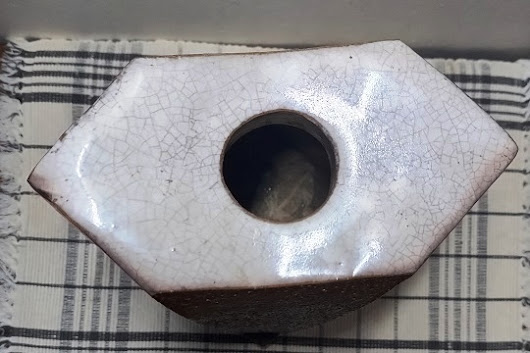239.
MIWA Eizō 三輪栄造, 1946‒99,
Hagi hanaire 萩花入 (Hagi-ware vase)
Miwa Eizō was the second son of Living National Treasure Miwa Kyūsetsu XI 十一代 三輪休雪. He graduated from the private Musashino Art University and was a member of the Japanese Traditional Crafts Society and often displayed his works at their national exhibitions (Nihon Dentō Tōgeiten). He was the recipient of the top prize at the Tanabe Museum’s prestigious Modern Tea Forms Exhibition (Gendai Cha no Yu Zōkeiten). ). Unfortunately, he died in 1999 at the early age of fifty-two. His brother Ryōsaku 龍作 succeeded to the family name as Miwa Kyūsetsu XII 十二代休雪. His works are held in the collections of, among others, the British Museum and the National Museum of Modern Art in Tokyo. For more on this artist, see The Ceramic Works of Eizo Miwa (2001), published posthumously by the Kuroda Tōen art gallery of Tokyo.
Dark gray clay, glazed on four sides with the white Hagi glaze, with two of these sides tinged pink from the flames (hi-iro); two of the sides and the bottom are a reddish brown; the lower parts of three of the sides were blackened by a build-up of ash deposits. Weight: 3.9 kg (8.7 lb). Height: 29.2 cm (11-1/2 in). Dimensions: of base, 13.8 cm (5-1/2 in) square; of top, 20 x 10 cm (8 x 4 in).
This is a six-sided figure, sitting on a square base. The remnants of the four posts used to separate the piece from the shelf during firing are visible on the bottom. The base is slightly less than a centimeter (3/8 in) high. The edges are beveled outwards to form a square 15.7 cm (6-1/4 in) on a side. Four of the walls rest on the base. The vase began as a square; two of the corners were then sliced away to form long triangles, 11 cm (4-3/8 in) wide at the top and tapering down to a narrow ledge 3.2 cm (1-1/4 in) wide at the bottom, sited about 3.2 cm above the base. This left the remaining four sides with three 90-degree angles and one long sloping side; these are about 7 cm (2-3/4 in) wide at the top and 15.7 cm at the bottom. The top is a six-sided figure, a lozenge with two pointed ends, forming equilateral triangles joined to a longer rectangle. The hole, 4.7 cm (2-7/8 in) wide is a circular opening to a vertical shaft about 2.5 cm (1 in) long. The top slopes inward from all sides toward the opening. It’s impossible to get accurate measurements, but the walls appear to be about a centimeter thick. The surface of this varies from very smooth in the glazed areas to rough and pitted in the sections with ash buildup.
The four-sided walls were glazed with the white Hagi glaze (Wikipedia has good information on this glaze; see under “Hagi ware”). On the front side (arbitrarily designated as the side with the most kiln effects), the glaze turned pink because of the kiln effects. On the back side and the top, the glaze remained white and exhibits much crackling. The two triangular sides are rich reddish brown. The bottoms of the two front four-sided panels were blackened by ash deposits during the firing and are mottled black, bluish gray, and white; the base of one of the back panels was lightly blackened during the firing. The interior was unglazed.
This came in a wooden box inscribed in two lines, 萩花入 (Hagi hanairei, Hagi-ware vase) and 栄造 (Eizō), followed by the artist’s seal stamped in red.
The appearance of this varies considerably depending on the side from which it is viewed. From the sides it appears to be a tall, rectangular vase, with dramatic contrasts of light and dark. Viewed from the front or back, with the triangular portions centered, the shape becomes much more complex. From the back side, it appears to be a highly glazed, mostly white piece; from the front, a richly colored vase dominated by a blush pink hue. A very substantial work.
Purchased
from the Kura Monzen Gallery in Kyoto, Japan, in January 2024 (invoice,
shipping and customs documents).












No comments:
Post a Comment